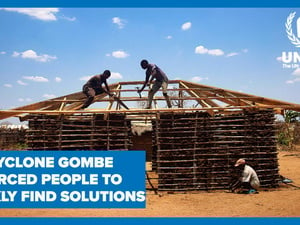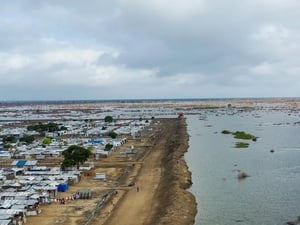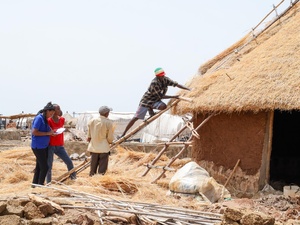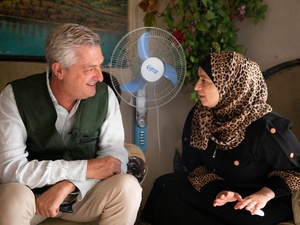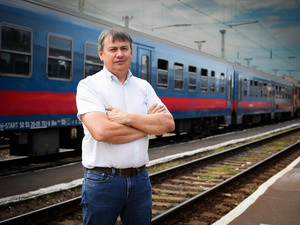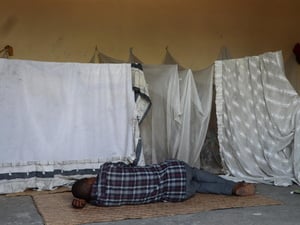Settlement and shelter
Settlement and shelter
We ensure they have access to safe, sustainable shelter within existing communities and work to strengthen the capacity of host areas. In emergencies, we also provide temporary shelter solutions to meet urgent needs.
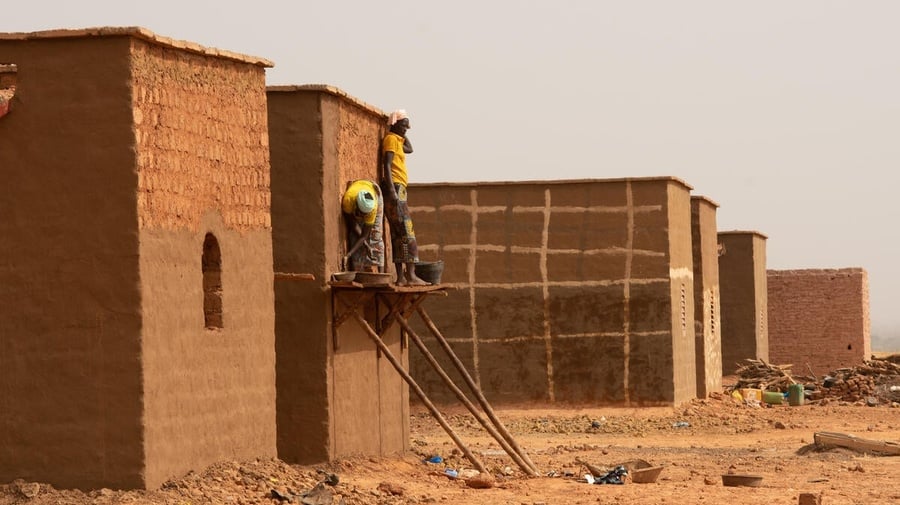
Internally displaced people and local masons build durable houses in Burkina Faso as part of a settlement and shelter programme supported by UNHCR.
When people are forced to flee violence or persecution, either within their country of origin or across borders, local communities often welcome them generously. However, this can put a strain on resources, causing overcrowding and service issues, which may lead to social tensions.
UNHCR aims to help forcibly displaced people find shelter in existing communities, such as in cities, towns or villages. We work with local authorities to provide services and infrastructure to meet the increased demand in host areas. We also help build and repair shelters to expand the availability of housing, and may also provide cash assistance so forcibly displaced people can rent or build shelters of their choosing.
Whenever possible, UNHCR advocates to avoid the establishment of formal camps to accommodate forcibly displaced people. Enabling displaced people to settle in existing communities helps them access basic rights, including education and health care, and find job opportunities, while allowing them to make meaningful choices and live with dignity, independence and normalcy. However, when no other alternatives exist, UNHCR will also step in to help plan displacement camps. During humanitarian crises, when large numbers of people are forced to flee at once, we also rapidly provide temporary shelter solutions.
Human Settlements
Text and media 24
‘Human Settlements’ is a holistic approach to creating sustainable, integrated communities for refugees and other people forced to flee, along with their hosts, enabling them to enjoy improved quality of life, economic development and self-reliance.
Human Settlements promotes resilient communities through climate adaptation, social equity, and participatory approaches while emphasizing strengthened infrastructure and services, that will benefit both host and displaced communities, in both urban and rural areas. Key elements include urban planning, enabling policies, access to jobs and livelihoods and climate action. In line with this, UNHCR works to help strengthen the capacity of cities or villages, that host displaced people. We help provide and strengthen services and infrastructure such as shelter, water, sanitation, renewable energy, solid waste management, communal spaces, land for livelihood opportunities, and connection to markets, educational and health facilities.
Human Settlements also supports the transition from temporary or formal camps to more sustainable, integrated forms of settlement, such as municipalities or planned urban areas.
Learn more about Human Settlements: View the Global Compact on Refugees Multi-stakeholder Pledge for Climate Resilient, Sustainable Human Settlements.
Settlement planning
Text and media 24 - Copy
When planning new settlements or expanding existing ones, UNHCR uses urban planning principles adjusted to meet the needs of displaced people and local communities.
A well-designed settlement balances the immediate and long-term needs of the displaced population and their host communities. These needs include access to water and sanitation, electricity, education, health facilities and livelihood opportunities, while also considering resource availability, socio-economic dynamics and climate-related risks. We aim to ensure the planning process is inclusive of the views of all concerned stakeholders, namely the displaced and host communities, local authorities, service providers and other relevant partners.
Camps as a last resort
UNHCR advocates to only use camps as a last resort, as they may limit the enjoyment of basic rights for forcibly displaced people. However, in some situations, there is simply no alternative but to establish camps to rapidly respond to needs of the displaced population.
UNHCR's Master Plan Approach ensures that settlement planning prioritizes protection and sustainability during displacement crises. As part of the Master Plan Approach, a multi-sectoral site assessment form helps choose new sites or expand current ones. A well-designed settlement protects the displaced people, ensures access to services, enables livelihood opportunities, safeguards the environment, and prevents hazards like fires and diseases.
Shelter
Text and media 36
At UNHCR, providing adequate shelter in a humanitarian emergency is a core part of our mandate. It is vital for the safety and well-being of forcibly displaced people. It protects them from harsh weather, provides privacy, an increased sense of dignity and a semblance of normalcy during crises.
There are a number of ways to house forcibly displaced people, including:
-
Emergency shelter: Temporary shelters that provide immediate protection for people forced to flee. They are often made from local materials such as wood or straw, or with tents and plastic sheeting.
-
Collective shelter: Shelters or buildings, such as schools or halls, used to temporarily house large groups of people while longer-term solutions are arranged.
-
Durable shelter: Longer-term housing solutions, like houses and/or apartments, that are connected to essential services. We prioritize using local materials and building techniques to ensure housing is culturally relevant and sustainable. We also advocate for housing, land and property rights for displaced populations.
- Shelter repair and maintenance: Technical support, supplies and cash-based interventions to help people to repair, expand and maintain shelters.
- Rental programming: Financial support so vulnerable refugees and other forcibly displaced people can rent homes of their choosing in existing housing markets.
We aim to provide sustainable and durable shelter solutions from the outset of an unfolding emergency. However, when large numbers of people flee at once, this is not always possible. In such cases, we may need to initially offer temporary shelter solutions to keep people safe. UNHCR works to transition emergency response efforts into more durable and sustainable housing solutions as soon as possible.
Minimizing our environmental impact
UNHCR is working to reduce the environmental impact of our humanitarian responses, including by using light materials that require less fuel during transport, and recycled plastics in the shelter items we procure and deliver. This is in line with UNHCR Strategic Framework for Climate Action, and the UNHCR Climate Action Strategic Plan 2024 – 2030.





